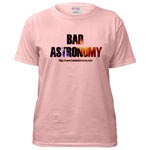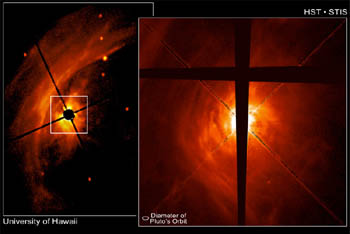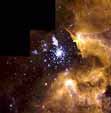
| Bad Astronomy |
|
|
|
BA Blog
|
|
Q & BA
|
|
Bulletin Board
|
| Media |
|
|
|
Bitesize Astronomy
|
|
Bad Astro Store
|
|
Mad Science
|
|
Fun Stuff
|
| Site Info |
|
|
|
Links
|
| RELATED SITES |
| - Universe Today |
| - APOD |
| - The Nine Planets |
| - Mystery Investigators |
| - Slacker Astronomy |
| - Skepticality |
Buy My Stuff

Keep Bad Astronomy close to your heart, and help make me
filthy rich. Hey, it's either this or one of those really
irritating PayPal donation buttons here.
More Neat News from Hubble
Week of June 7, 1999 This was a big week for astronomy news! Twice a year, the American Astronomical Society (AAS) holds a meeting. Usually a couple of thousand astronomers show up and discuss current findings, news, job information and the like. June 1999 was the 100th anniversary of the founding of the AAS, so it was a big meeting. The held it in Chicago, and this year unfortunately I could not attend (my grant travel funds were used up last year for a meeting in the Canary Islands, isn't that just too bad? ;-)But I was there in spirit. There were two press releases that I had a hand in, and one in which I have great interest and marginal involvement. Part of the idea of these Bitesize pages is to bring current news to people's attention, so this is a good opportunity to show you some interesting events in astronomy. I'll be brief, with just a line or two of explanation, and then just have a pointer to articles with more info. These articles may not be live after some time has passed since the websites are news sites; if the links die please let me know so I can update them! In all cases, you can go to the sites mentioned to get bigger and higher resolution images. Incidentally, all these news stories and many more can be found at the astronomy news websites linked from my Good News page.
 First,
the Space Telescope Imaging Spectrograph
was used to make images of a young star that is still wrapped in
the disk of material from which it formed. The images show that the
disk is not smooth: it has clumps as well as what look like
spiral arms (though they are very different from spiral arms
that are in galaxies). It may be that planets are forming in that
disk right before our eyes. I am involved in the project to use STIS
to observe such stars; although I didn't create the images here, I
did work with the project's Principle Investigator on the data.
More info can be found at
the Space Telescope website, at
Astronomy Now or at
CNN's Science site.
First,
the Space Telescope Imaging Spectrograph
was used to make images of a young star that is still wrapped in
the disk of material from which it formed. The images show that the
disk is not smooth: it has clumps as well as what look like
spiral arms (though they are very different from spiral arms
that are in galaxies). It may be that planets are forming in that
disk right before our eyes. I am involved in the project to use STIS
to observe such stars; although I didn't create the images here, I
did work with the project's Principle Investigator on the data.
More info can be found at
the Space Telescope website, at
Astronomy Now or at
CNN's Science site.
 Next, STIS was used to observe the amazing star Eta Carinae. Eta,
as astronomers in the know call it, is a huge star, possibly 100
times the mass of the Sun, and possibly the brightest `normal' star
in the Galaxy. It is surrounded by a vast cloud of gas that it has
ejected in its tempestuous lifetime. The star undergoes episodes of
violent mass loss, and recently has doubled in brightness. We don't
know if this is a normal part of its lifecycle or if it's about to undergo
another outburst. Either way, we need to keep an eye on it!
I am working directly on the project to monitor Eta with STIS,
and also put together some images of it. The image above shows
changes in one part of Eta Carinae's spectrum in a little over a year.
Don't worry about the details; just note that most stars' spectra
change a tiny bit over decades or centuries, but Eta's can change in
just a few days! [Click on image to get a bigger version!]
Next, STIS was used to observe the amazing star Eta Carinae. Eta,
as astronomers in the know call it, is a huge star, possibly 100
times the mass of the Sun, and possibly the brightest `normal' star
in the Galaxy. It is surrounded by a vast cloud of gas that it has
ejected in its tempestuous lifetime. The star undergoes episodes of
violent mass loss, and recently has doubled in brightness. We don't
know if this is a normal part of its lifecycle or if it's about to undergo
another outburst. Either way, we need to keep an eye on it!
I am working directly on the project to monitor Eta with STIS,
and also put together some images of it. The image above shows
changes in one part of Eta Carinae's spectrum in a little over a year.
Don't worry about the details; just note that most stars' spectra
change a tiny bit over decades or centuries, but Eta's can change in
just a few days! [Click on image to get a bigger version!]
For more info, take a poke at Goddard Space Flight Center's Public Affairs website. You'll find some images I did there too. Astronomy Now has an article too, with a graphic I made for this project (my name is on it... ah, fame! ;-).
 Third, a new Hubble image was released of the beautiful object called
Sher 25. It is a lot like
SN 1987A,
a star that exploded in 1987. However, this object is 10 times closer!
We're not in danger from it (it's still along way off), but the cool thing
here is that since it's closer, we can see it in more detail. Also,
we are seeing it before it explodes, so we can look at just
what happens to a massive star before it goes kablooie! Plus, it's
just a terribly beautiful and impressive picture. ;-)
Third, a new Hubble image was released of the beautiful object called
Sher 25. It is a lot like
SN 1987A,
a star that exploded in 1987. However, this object is 10 times closer!
We're not in danger from it (it's still along way off), but the cool thing
here is that since it's closer, we can see it in more detail. Also,
we are seeing it before it explodes, so we can look at just
what happens to a massive star before it goes kablooie! Plus, it's
just a terribly beautiful and impressive picture. ;-)
While I am not directly involved with this project, I have exchanged email with the investigators about the object (I was the referee on a fine paper they wrote about Sher 25 last year). Since it is so much like 1987A (which I studied for my PhD) I am fascinated by Sher 25 and I hope to be involved with it or objects like it in the future.
For more info about Sher 25, once again go to the Hubble website.
|
|
| THE PANTRY: ARCHIVE OF BITESIZE SNACKS |
|
|
| Subscribe to the Bad Astronomy Newsletter! |
| Talk about Bad Astronomy on the BA Bulletin Board! |